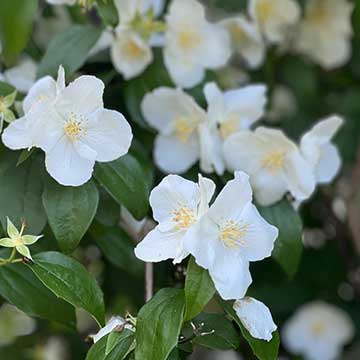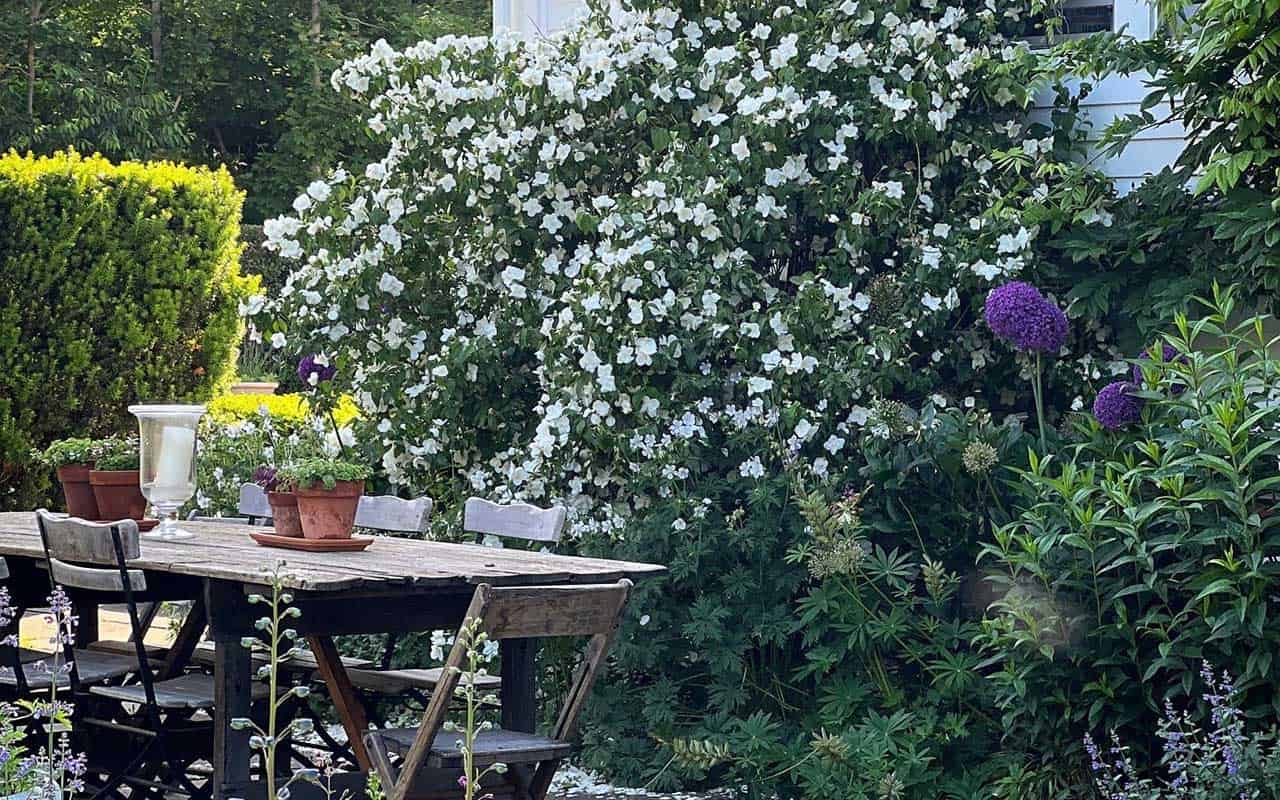It was the best of times, it was the worst of times. While Charles Dickens may well have been talking about two cities, my tale of hope and despair is about two scents – or rather one distinct lack of scent. However, the shared moral of both our stories is that things are not always what they seem.
We spend a lot of time on the visuals when planning gardens and sowing seeds – how plants look both in the garden setting and in the vase, their color, shape, height, and how they blend together. While sight followed by taste may take priority, it’s important to consider all five senses to determine what makes the cut. Think of the velvet bliss of rubbing Lamb’s Ear leaves or listening to the sound of the trees in the wind. And what on earth, pray tell, would a garden be without scent?
I’m inspired to ask because of two recent flowering events in my garden and how they each highlight the crucial importance of scent when planning our gardens.
Philadelphus
The first was the bloom of my philadelphus shrub, or as it is often known, mock orange, outside my kitchen window. This was one of the very first shrubs to be planted here when I started our garden ten years ago. Certainly, it is one of the oldest surviving plants in our garden. (It took me a while to realize that recreating an English garden in the New England climate might not be as easy as just replicating my grandmother’s planting plan.)
 In it went under our kitchen window and there it stayed, seemingly happy as Larry, putting on growth every year and flowering like a maniac every June. Beautiful floriferous blooms – it looks stunning. A huge win one might think. Apart from one major downside.
In it went under our kitchen window and there it stayed, seemingly happy as Larry, putting on growth every year and flowering like a maniac every June. Beautiful floriferous blooms – it looks stunning. A huge win one might think. Apart from one major downside.
I call it a downside to be polite. For what it actually represents is a travesty of epic proportions. In fact, I think it’s fair to call it a crime – a crime against all gardeners, perhaps even all humanity! For, when purchasing this plant back when I wasn’t quite so garden savvy, I was completely unaware that there existed an unscented mock orange – because why would there be? The whole point of a mock orange is its scent! I clearly didn’t read the label properly – philadelphus inodorous. Somehow, sometime, someone had thought it clever/appropriate, actually God only knows what they were thinking when breeding this plant, to sacrifice its heart and soul, its very essence in return for more brash showy flowers. My grandmother would perfectly describe it as “all fur coat and no knickers!”
I cannot tell you the disappointment its blooming evokes every year. The “if onlys,” the “what might have beens,” the whole house, upstairs and down, filled with its deep delicious scent. Balmy June evenings sitting on the terrace enveloped by its heady aroma. Snatches of it caught on the breeze at the far end of the garden. Instead? Nada, nothing, not even the faintest whiff. We’ve got to the point now that its show-stopping visual beauty is as good as a malicious and torturous poke in the eye.
The power of smell
Yet, around the same time, at the other end of the garden comes a single ten-inch stem of ethereal delicacy – my first sweet pea of the season. Just one single flower and I’m in olfactory heaven, seemingly catapulted back in time to so many ages, events and places in my life. My grandmother’s garden, our kitchen table at home growing up, my wedding day, lazy summer lunches…. one inhale can transform me into my own version of a time-travelling Dr Who.
How? Why? What? Because that is the power of smell. It is way beyond me to explain the intricacies of the brain and how this happens, but suffice it to say the group of brain areas that process emotions, learning, and memory also process odors. This gives smell a stronger link to memory and emotion than any other sense. Hence one sniff can immediately trigger a detailed memory or intense emotional reaction. Thus, my unadulterated joy over a sweet pea flower – along with my sense of loss/outrage of the what might have been for my scentless mock orange.
Studies have shown that smell triggers 75% of our daily moods. I talk a lot about the mental health benefits of gardening. (Truly there is no greater reminder that “this too shall pass” than being at the mercy of the seasonal shifts of the gardening year.) So, ensuring we include as many mood-boosting scents in our outside as well as our inside spaces seems like a pretty fail-safe and easy way to tap into these.
Problem? Here are solutions.
Aside from packing our traditional flower beds with our favorite roses (that is if you can grow them – for whatever reasons, I cannot), how can we introduce more scented wonder into our growing space? The options are endless.
What if you don’t have a garden? Scented geraniums in a window box.It’s the depths of winter? Forced hyacinth bulbs. Run out of horizontal bed space? Try a climbing honeysuckle. Shady area with little sun? Plant some lily of the valley. Only grow vegetables? Tell me the scent of a vine-ripened tomato shouldn’t be bottled.
So, no excuses! Be it shrub, perennial, annual, bulb, or climber, don’t miss the opportunity they each present to turn your garden into a scented, joy-giving, emotion-rich haven.
I think it is also worth saying here for those of you who might consider yourselves lacking a green thumb or who get overwhelmed by the seeming myriad of elements to gardening, focusing for now on just scent could be a good way to start your gardening journey. Keep things simple – literally a scented pelargonium by your door – and build from there. You’ll be amazed how easy it really can be.
But one absolute word of warning before you start. If you see the word “inodorous” on the plant label, place it back on the shelf, turn, and run! •
Pom Shillingford is an obsessive gardener originally from England and now based in Salisbury, CT. She offers seasonal cut flowers through English Garden Grown. Find her on Instagram @english_garden_grown.

